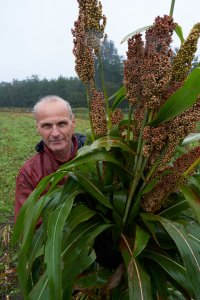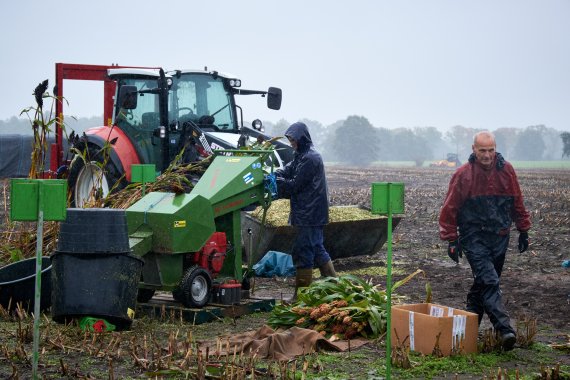photo’s Guy Ackermans
On the outskirts of Woudenberg on this first Tuesday of October, a cereal crop is being harvested on the land of farmer Van de Vliert. But don’t expect a harvest festival. Heavy drizzle has turned it into a somewhat depressing exercise. Gerrit Kasper, an animal feed researcher at Wageningen Livestock Research, is busy bringing in the sorghum from his trial fields. That is manual labour: Kasper collects the sorghum that his colleague Henk Schilder saws off just above the ground with an electrical hedge trimmer. It seems rather amateurish but there is no room for larger machinery on plots measuring 6 by 2.5 metres.

Researcher Gerrit Kasper of Wageningen Livestock Research.
Soil depletion
The cultivation of sorghum is a new phenomenon in Dutch fields. There are a few experiments going on here and there (see inset) but no large-scale production for animal feed as yet. But that will eventually happen if Kasper has anything to do with it. He sees sorghum as a good alternative to maize.
Maize was successfully introduced in the Netherlands about 60 years ago. Farmers are very happy with it, says Kasper. ‘It’s a good crop in terms of energy yields, but the protein content could be higher.’ There are other downsides to maize as well. ‘The crop isn’t very good for the soil. Growing maize over a long period gradually reduces the quality of the soil. Monocultures in Brabant and the Achterhoek region in particular suffer from this problem. So we started to look for an alternative, a third animal feed crop for dairy farming alongside maize and grass. Sorghum could be that crop.’
Sorghum spares the soil, is less susceptible to disease and can cope better with drought.
Long roots
Sorghum’s big advantage according to Kasper is that it puts down deep rootst that are finely meshed. While maize’s finer roots get down to about 60 to 80 centimeters, sorghum makes two metres. ‘What’s more, the root system is much finer and denser, which has a positive effect on the soil structure. The roots that remain behind also sequester more CO2 in the soil. As a result, sorghum does more to combat climate change than maize.
From the perspective of soil quality, sorghum has another plus side too: it makes better use of nitrogen fertilizers than maize. Kasper: ‘Maize does not take up all the nitrogen that is added, so some leaches into the soil as nitrate. In comparison with maize, sorghum leaves little or no nitrate behind in the second part of the growing season. The water boards in particular are very interested in sorghum for precisely that reason.’ Sorghum also suffers a lot less from disease than maize and needs a quarter less water. Those are useful characteristics in a time of climate change and dry summers like we had this year.
(text continues below picture)

Busy demo day
That is the theory based on research in other parts of the world. But it all still has to be demonstrated for Dutch fields. Trials in Woudenberg (Utrecht), Wijnandsrade (Limburg) and Oldeboarn (Friesland) will provide the initial answers. The soaking wet plots in Woudenberg have been planted with five varieties of sorghum, with maize as the control. The plants are in sandy soil. The experiment here focuses on the effect sorghum has on the moisture content of the soil and nitrate leaching. In the Limburg loess, the effect of different amounts of fertilizer is being studied and in the peat soil of Friesland the main topic is tillage. Each project has its own sponsors: local water boards, the provincial authority, a local water supply company, an experimental farm or an area organization.
The recent demo day in the Woudenberg trial fields attracted 75 attendees, including a lot of farmers. So there is clearly interest. But it takes more to get the fields full of sorghum. Sowing is one area of concern, for example. Sorghum seeds are ten times smaller than maize seeds. What tillage methods and machinery do you need to sow something that small? Sorghum is also more susceptible to sub-zero temperatures than maize. Kasper: ‘That is why this cereal needs to be sown three to four weeks later than maize. It also grows more slowly than maize. The crop comes from the tropics, where the days in the growing season are shorter than they are here. So we still need plant breeding to adapt it to longer days.’
Milk yield
The sorghum in the Woudenberg fields is fed straight into the chopper on site. Part of the sorghum pulp will be measured in Wageningen to determine the amounts of dry matter, protein, lignin, starch, sugar and energy. Another part will be turned into silage to get an impression of feed losses during the silage process. This is also in preparation for the next stage of the research: a consumer survey. If they can get the funding, a three-year programme will show how cows digest the tropical crop. And most importantly, what effect it has on milk yields.
**Guinea corn
Sorghum – (Sorghum bicolor) or Guinea corn – is a grass-like cereal that originated in Africa. In the 17th century, African slaves brought it to the United States where it is now cultivated on a large scale as animal feed and an alternative to maize. Sorghum is an important food crop in Africa, Central America and South Asia, and it is the fifth most cultivated cereal crop. The Dutch also call it ‘kaffer’ corn: ‘kaffer’ is an insulting name for the Bantu people of South Africa.
**Sorghum pioneers
Wageningen Livestock Research is not the first to investigate the potential of sorghum as animal feed. The real pioneer is the Zeeland farmer and retired plant scientist Walter de Milliano, who has been breeding sorghum for cultivation in the Netherlands since 2005. Some of the varieties Livestock Research uses come from De Milliano. The Louis Bolk Institute, which Livestock Research is also collaborating with, has been experimenting with sorghum cultivation for about six years. Their experiments show that sorghum produces five to ten percent more protein than maize. Stopping maize cultivation for one year to grow sorghum increases the next maize yield by seven percent.
